|
|
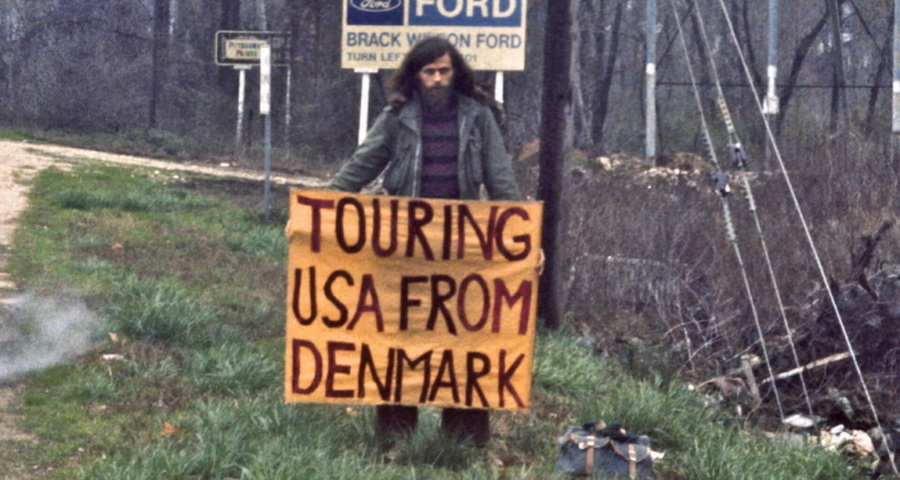
Jacob Holdt’s American
Pictures:
A Note on Style in Poor Cinema
J. Ronald Green
Who says
that fictions only and false hair
Become a verse? Is there in truth no beauty?
– George
Herbert, Jordan
(I),
c. 1633
In connection with its recent (Apr 21-Oct 31,
2021) one-person show of the work of Black American filmmaker,
Arthur Jafa, the Louisiana Museum of Modern Art, north of
Copenhagen, sponsored a conversation between Jafa and Danish
photographer and filmmaker Jacob Holdt. To open the discussion, Jafa
said to Holdt: “I grew up in Clarksdale, Mississippi, in the middle
of the Delta. I love William Eggleston’s work quite a bit. And it’s
obviously very great work as political photography. But I always
felt like there’s a wall of aestheticism between what it is he takes
pictures of and the work itself. And that’s not a critique, that’s
just a part of his work. But I just had never seen images of the
South before I saw your pictures, outside of my family’s photo
albums – that would be like the only equivalent of it. If I had to
put one question to you it would be how did you get these pictures?
How did you manage the level of intimacy or access?” Holdt responded
that “an important answer to your question is to travel with no
money.”
This essay is a heuristic exploration of a
cinema of poverty. Holdt’s
film – composed of still photos, intertitles, and sound – represents
a life-long, in-person testimonial of American poverty and racism.
Holdt deploys familiar attractions such as spectacle, sex
and violence,
and celebrity to
dramatise his portrayal of American inequities. I would expect
viewers of American
Pictures to
relate, as I did, and as Jafa did, to the life-long, life-risking
breadth and depth of this outsider filmmaker’s picture of the USA.
That picture, produced in the 1970s and ‘80s, is as relevant today
as it was then; in fact, Holdt – in response to the Black Lives
Matter movement – is currently updating the book that he produced
from the slide show and film—the working title of the updated book
is “Roots of Oppression”. My
own book discusses details of the original film version of American
Pictures,
including content, methods, critical targets, and issues. It
analyses those details in the light of the film’s effectiveness and
critical integrity, particularly in relation to money. The analysis
sometimes compares richer cinemas to Holdt’s film, but the focus
remains on poor cinema. A companion book manuscript focusing on rich
cinema also exists, in draft. This analysis of poor cinema grew out
of my two books on Black filmmaker, Oscar Micheaux, where I argued
for a middle-class cinema, an idea supported by analysis of the
content and style of all Micheaux’s extant films.
The idea of
“poor cinema” is discussed in the last two chapters of the
poor-cinema book manuscript, and will not be dwelt on in this essay,
except to say that the idea is related to prior formulations in the
film-studies canon such as Julio Garcia Espinosa’s essay, “For an
Imperfect Cinema,” and Fernando Solanos and Octavio Getino’s
manifesto, “Toward a Third Cinema,” as well as the film movements of
Third Cinema and Tricontinentalism discussed in the edited
collections Questions
of Third Cinema and “Rethinking”
Third Cinema.
More recently, the poor-cinema idea has been briefly summarised and
re-theorised by Hito Steyerl in The
Wretched of the Screen.
The above
exchange between Jafa and Holdt about the origins of Holdt’s
intimate, authentic pictures of Black American life, was primarily
concerned with the content of
Holdt’s pictures. Most of my book on American
Pictures also
deals with content and its relation to money. But the same poverty
that conditions Holdt’s content, may also affect his aesthetics,
which is another of Jafa’s and Holdt’s concerns. A close look at
Holdt’s film suggests how a “poor” style – analogous to Oscar
Micheaux’s style in racist 1920s and ‘30s America – can have a
discoverable aesthetic, a style unique to its material condition.
Below I
analyse instances of Holdt’s outsider style using detailed analyses
of shooting, editing, and mise-en-scène in order to show how style
may relate to money, and to show how a better-capitalised film style
might structurally lack the same interest, authority, and
effectiveness as Holdt’s under-capitalised project.
The Shot
A close
analysis of certain elements of Holdt’s shots results in
quantitative information such as the following:
Shot
Distance
|
Extreme Long Shot |
0% |
|
Long Shot |
60% |
|
Medium Shot |
32% |
|
Close Shot |
7% |
|
Extreme Close Shot |
0% |
Shot
Angle
|
Straight On/Perpendicular/90-Degree |
20% |
|
Oblique Side |
53% |
|
Acutely Oblique (hereafter “Acute”) Side |
27% |
|
Oblique High |
38% |
|
Acutely Oblique (hereafter “Acute”) High |
9% |
|
Oblique Low |
4% |
|
Acutely Oblique (hereafter “Acute”) Low |
0% |
|
Rear |
4% |
|
Extreme/Dutch/Tilted Horizon |
0% |
This simple analysis describes a shooting
style. It
would be rash to generalise too much from abstract figures such as
these. In order to know the aesthetic effect of such a high
percentage of long shots and medium shots; of the almost-complete
absence of extreme distance, extreme closeness, and extreme angle;
of the low but still-substantial incidence of close distance; and of
the very high percentage of oblique angles, one would need to select
some specific examples and see how those shot characteristics work
to produce beauty, effect, and meaning.
The
following, for example, is a very typical shot that I would classify
as an oblique side-angle, oblique high-angle, long shot,
statistically the most common type of shot among the analysed shot
characteristics in Holdt’s film.
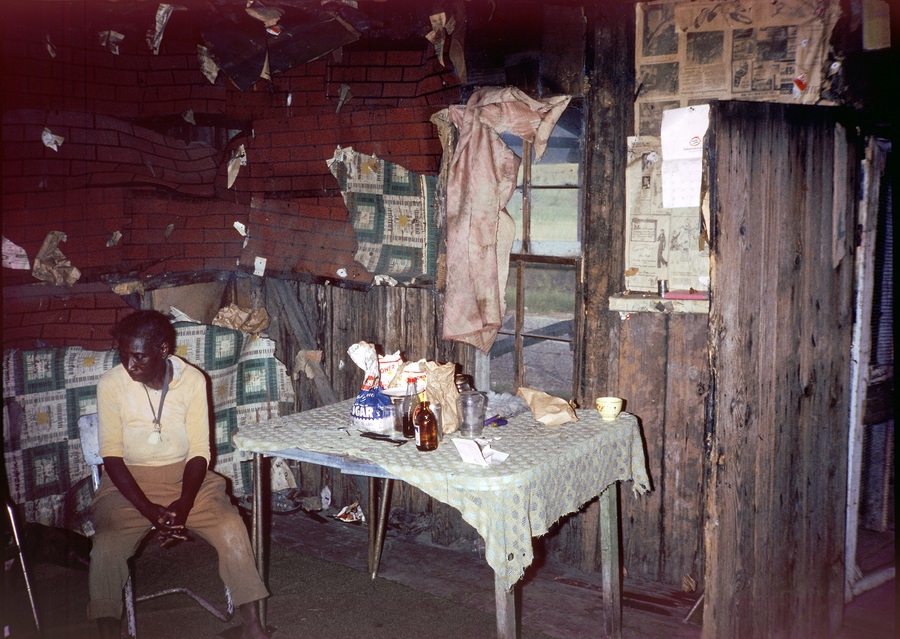
The side and high angles
are oblique and thus less photographically expressive or expressionistic than a
shot set at an acute angle from the subject matter. This leaves the content of
the image to speak for itself more than it would be able to do if the
photographic medium were insisting on its expressive prerogatives. The
conjunction of the high and side angles lend the objects a degree of dynamic
potential, owing to tensions set up in relation to the force of gravity, and by
the complex, almost cubistic lines of graphic force nested within the 90-degree
rectilinear frame. The unbalanced, cubistic qualities stimulate the eye and
brain, which aestheticises the image, rendering it recognisable within a canon
of social documentary image making, much of which could be categorised as, in my
terms, “poor” photography and cinema, a tradition that extends from, say, Lewis
Hine to the Film and Photo League and beyond – in that sense, nothing new.
The dominant effect of those oblique angles is
to present an account of the photographer’s experience of the
represented situation, suggesting an attempt to be faithful to the
effect of the observable surroundings in the picture. Thus, the
aestheticising dynamics and cubism of the shot result simply from
the photographer’s wish to get all the graphically rich, but also
crushingly decrepit, clutter on both walls and on the tabletop into
a single shot, and by doing so, to communicate his perception of
this woman’s over-determined situation. Holdt’s stylistic choice –
to shift angles slightly, rather than considerably – renders the
situation faithfully; at the same time it strengthens a Kantian
sublimity inherent in the condensed clutter, the byzantine
corruption of the represented life world, all this rendered
slightly, but unnervingly, unstable by the tilted camera angles. The
content shows the uncountable evidences of a general textural
fragility; the style shows the potential for collapse.
Moving
closer in another environment, the scene below is a typical oblique
side-angle (almost straight-on angle) medium shot.
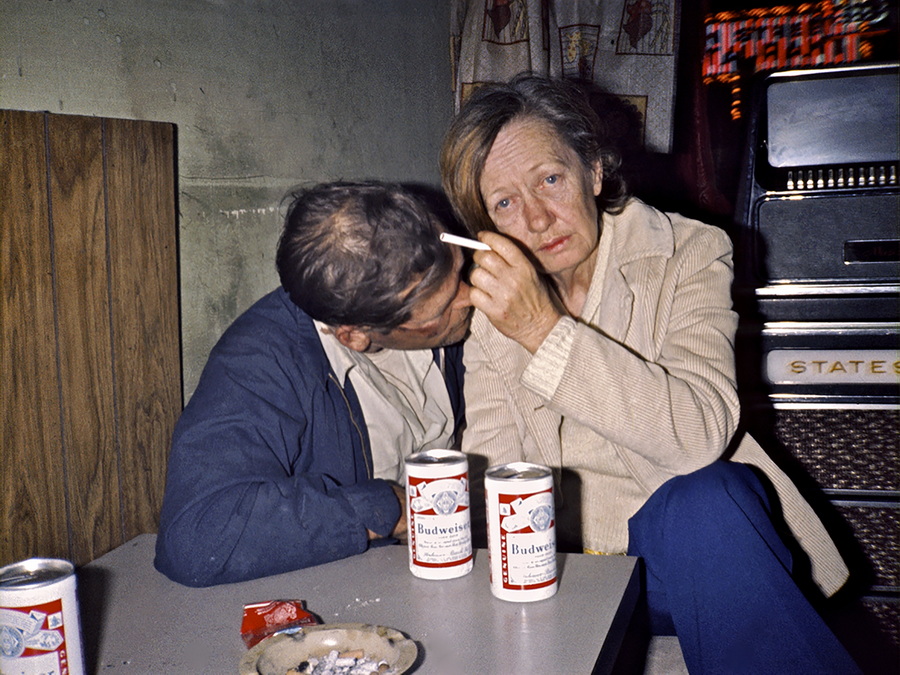
In this
case, the aesthetic arrangement seems dominated by the balancing of
graphic line and mass, and the isolated weights of colour. A massing
of graphic incident and colour-density on the right quarter of the
picture is balanced by the brown slab of veneer on the left frame
line, by the very stable, three-dimensionally bottom-heavy, blue
triangle of the man’s sweater, and by the photographer’s beer can
anchoring the lower-left corner of the composition. The strong
graphic line running from the woman’s legs through her elbow and
face is balanced by an equally weighty line running from the
lower-left-corner beer can across the couple’s two heads, producing
a triangle of graphic forces, which is offset a few degrees from the
vanishing point that is located somewhere to screen-right of the
woman’s left shoulder.
That
triangular crossing of massive lines supports the subjects’ worn and
weathered heads, and cradles those heads in a graphically – and
emotionally – complex nexus of graphic forces. For example, another
line runs from the same lower-left beer can across the man’s right
elbow and forearm to his invisible but strongly implied left hand,
which crosses behind, and presumably holds onto, the woman’s waist.
The added triangulation adds strut-like stability to the dominant
triangular mass converging at the two heads. The man’s unseen but
inferable embrace of the woman also conveys ambiguous emotional
strength to the zone of the picture where the graphic forces are
gathered. The prominent graphic lines of depth created “naturally”
by the optics of the lens also come into play, creating another
system of triangulations at the acme of the vanishing point, this
time adding third-dimensional weight to the arrangement.
The effect of a converging of two-dimensional
and three-dimensional graphic forms near a single point is further
strengthened by a more subtle graphic line – suggested primarily by
the fragmented, but nonetheless strong, line of white dots on the
juke box to the right. That bright, rigid broken line is faintly
mirrored by a lighter line of white dots on the wall to the left of
the man’s head. That line crosses the woman’s eyes. There is a
punctum near
that crowded crossroads that is located in the glance of the woman
straight at the camera and the viewer. Her direct glance projects in
the exact opposite direction from the graphic lines of depth created
“naturally” by the optics of the lens. Her glance at us reverses
perspective and forcefully breaks the fourth wall of the picture’s
implied space. The strut-like triangular form resulting from the two
lines of force emanating from the lower-left beer can adds another
slight cubistic effect, suggesting a counter-intuitive vanishing, or
emanating, point at that beer can, an apex to a triangle. Since that
apex is in the third dimension, it helps pop the couple’s heads and
upper bodies out of a seemingly chaotic background that is
succumbing to the receding – perhaps threatening – vanishing point.
This could be read as optimistic, and the optimism could be related
to the subject’s connection with the photographer, and the viewer.
There is
much more that could be said about the aesthetics of this quite
ordinary shot. For instance, the cheap, single-point, flashbulb
lighting creates shadows at several points of the picture’s depth,
which tends to spray pitch-dark graphic weight along diverging lines
defined by the single-point, reverse-“perspective” of the flash-bulb
light source. These dark divergences add cubistic tension when felt
or perceived in conjunction with the complementary, vanishing-point
system controlled by the lens. In a different graphic register, the
various red objects and shapes seem to reinforce a general tone of
light-redness to the flesh of the couple, and the hair, lips, and
eyelid redness of the woman. And so forth.
Given the
aesthetic density of the shot, is it then to stand accused of
aestheticism, of making poverty and desperation beautiful? Possibly,
but I think not, first, because the aesthetic events in the shot are
patently uncontrived, unarranged, and non-intrusive. One must do
conscious work to see most of the aesthetic elements discussed
above, and even more work to analyse how those elements might be
working metaphorically and emotionally – to see, for example, that
the vanishing point drawing this couple into its third-dimensional,
background vortex is “countered” by the appeal of the direct glance
reaching out of that ineluctable background vector toward the
photographer and toward the viewer. Without such analytical labor as
has been expended here, however, what one sees is a very ordinary
snapshot of a bar scene, arguably clichéd and bathetic –
nevertheless, the effects discussed above may be felt without being
analysed.
Below is an
even less prepossessing picture, an oblique side-angle, oblique
high-angle medium shot.
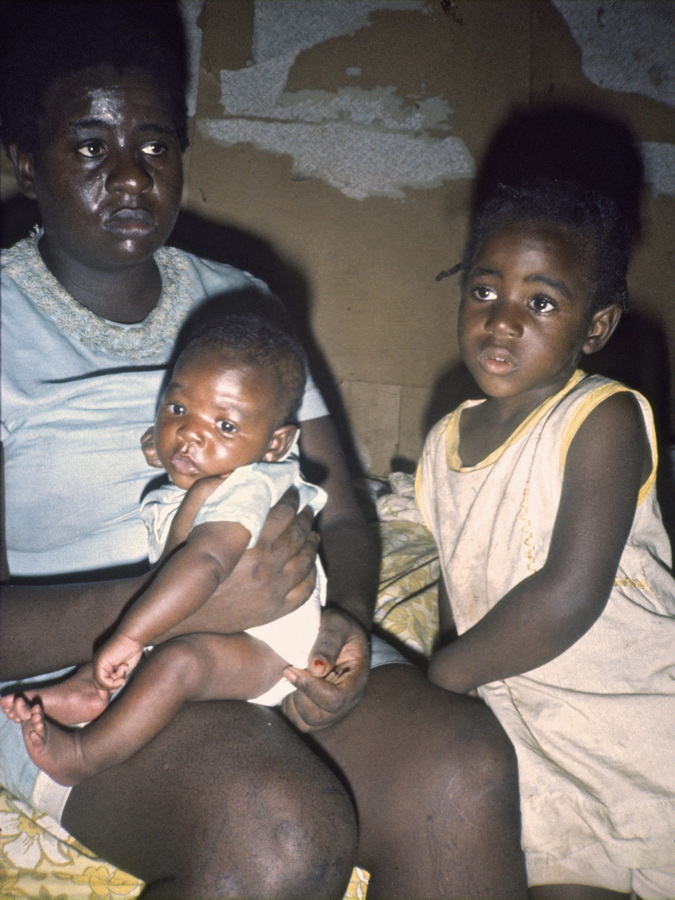
This must be
one of the most amateurish shots in Holdt’s project, but, there is
again another way to see its amateurism. If one considers the
expressionistic effect of the single-source lighting – the
flashbulb’s shadows as uncanny distortions of the bodies, the
uncertainty in the eyes of the subjects, the dynamics of facial
expressions and lighting contrasts, the abstract-expressionistic
forms on the wall behind and above these people – this shot again
can become a powerful, even sublime, aesthetic experience. Something
terrible but undefined and alarmingly other-dimensional is happening
to these people; they know it, the photographer captures it, and we
can sense it.
Again, all
three of these shots are aesthetically powerful, but unaestheticised
in the sense that Jafa is concerned about in relation to Eggleston.
Eggleston’s work is painterly. Holdt seems in no way to be
consciously producing beauty, but somehow he is producing, in
virtually every shot, aesthetic sublimity in the Kantian sense –
i.e., a visually stylised sense of overpowering dread that is
inherent in the content and expressed in its forms.
We have seen
how the sublime effects may be created in these shots, but how might
these accomplishments be related to money?
Considering
the last example first, a representation of the “terrible but
undefined” thing that is happening to these people might also be
produced by a highly paid, better-equipped, better-trained
photographer than Jacob Holdt, such as Eggleston, or another
photographer of the South that Jafa mentions, Birney Imes. However,
as Jafa directly implies, pictures such as Holdt’s would be anathema
to such an artist. Even if they wanted to, it would be hard for a
professional photographer to duplicate the quality of the focus in
the shot above – it is not really “soft” focus, and not an
adjusted-focus effect, but rather a product of inadequate light for
the modest quality of the lens. The flash effect that is providing
all the necessary light would be assiduously avoided by a
photographer equipped with a better lens, a multi-point lighting
setup, and the training and skills that would allow the unobtrusive
and invisible handling of those capital assets. Such a photographer
or cinematographer could hardly even imagine such a picture, much
less as a desired objective, nor would any well-paying magazine or
film producer – such as National
Geographic or
CBS, or Random House or Secker and Warburg (publishers of some of
Eggleston’s books), nor even the committed socio-political work of
Magnum Photos – likely pay for such a picture. Such venues, and
virtually any venue investing significant money in such image
content, would expect to see their investments returned in profits,
and would feel the need to see conscious, identifiable aesthetic
value – some perceptible beauty – added to the content of the
images. That
is part of what well-capitalised media mean when they demand minimum
technical standards, and they use their capital to produce work
whose standards only capital can meet. By definition, the picture of
the mother and two children under discussion here is sub-standard in
that discourse, and thus money is very relevant to the production of
such an image.
The same can
be said for the other two images above – that is, that, in the more
capitalised discourses of film, they are all technically
sub-standard. As a consequence of the images’ poor fit within the
better-capitalised systems, the aesthetically high-quality
characteristics of the images that are identified in my analysis
above are perhaps not readily recognizable. Analytical labor is
required in order to demonstrate those aesthetic qualities, a
characteristic not sought by well-capitalised film producers. Such
analytic labour was necessary for every scene in every film
discussed in my two books on Oscar Micheaux; and prior to that
particular labour, Micheaux’s work had been considered by most
critics as important only for its content, not for its aesthetic
power and originality.
It may be, then, that only a poor cinema can
deploy many of the particular aesthetic effects analysed in the
images above, effects that avoid traditional beauty but reach an
aesthetically rich sublimity apparently dependent on financial
poverty. Jafa implies as much in his questions to Holdt in the
interview mentioned above, where Jafa also says: “In my own
particular upbringing in the Delta, which is[,] outside of the
Appalachians[,] in the poorest region in America, I feel like
poverty was more defining than culture, so to speak, or even race.
The culture grows out of the poverty, or is inflected or deflected
or shaped by the poverty.”
Editing
So far, I
have been discussing film stills that might as well be – in fact are
– also in a photography book. They are, however, also the visual
elements in one of the most powerful films I’ve ever seen, which is
the object of this essay. The primary difference between book and
film is temporal editing. Virtually every edit in American
Pictures is
efficient and discernibly relevant to the discursive vector. Many
edits are worthy of special comment for their skill, and some are
utterly brilliant. For example, within the first couple of minutes
of the version of Part I that is presently available for streaming
on Holdt’s website, one
finds an image of a white woman in the foreground and a black woman
in the background.
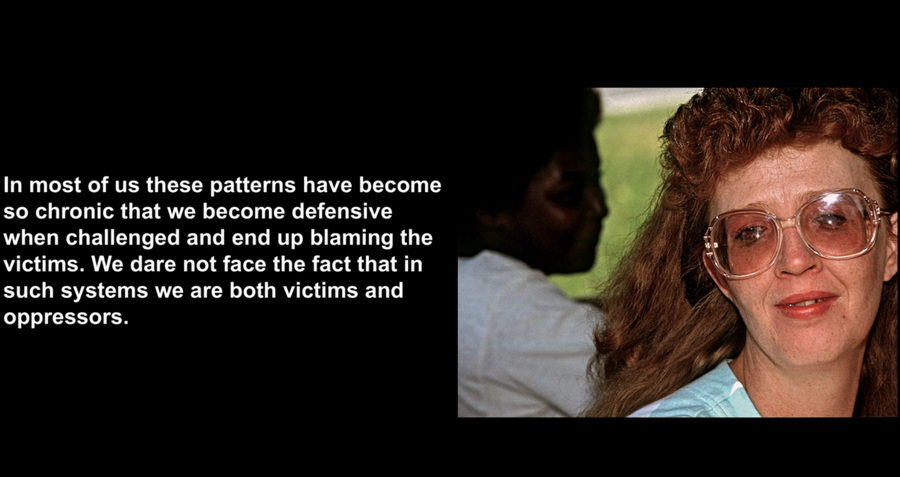
Before the
next edit occurs, one can hardly help noticing that the two women, though in the
same frame, are treated differently by the shot. The white woman is in the
foreground, body and face toward the camera, looking up and only slightly off
the camera’s axis of orientation—she is in classic suture position, seemingly
ready for a reverse angle edit along the axis of the shot; the black woman,
however, is in the background, body turned away from the camera, face looking
slightly down and almost ninety degrees off the axis of the shot. The white
woman is in classic position, seemingly ready for a reverse-shot to any
pro-filmic interlocutor that might suture the white woman with the eavesdropping
viewer. The black woman is a more distant object in every way, not positioned
for suture with the viewer, but nonetheless observed by the viewer. It is a
disturbing image in its own right, since the emotional appeal of the ingenuous,
outgoing, confident white woman is burdened by the recognition of the pensive,
diffident, more alienated black woman. The next full image is a powerful
statement of that same relationship, but in a different register.
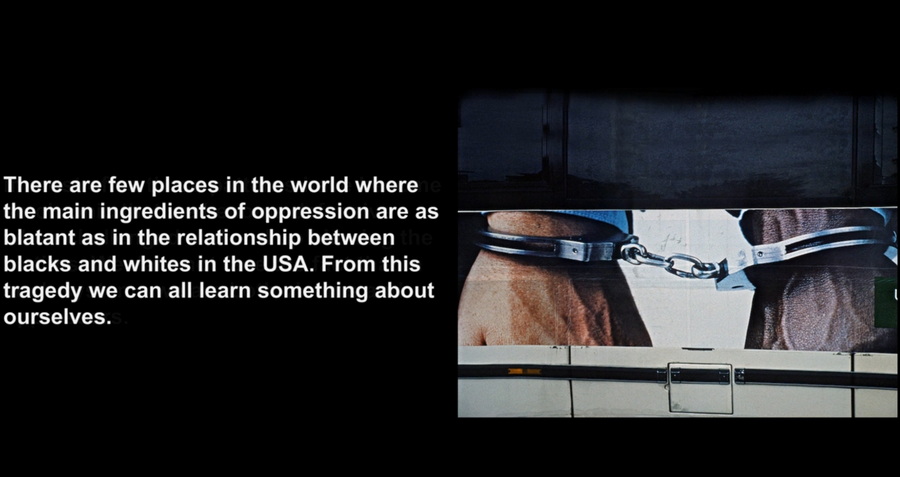
This image of
black and white Americans handcuffed together would be a strong edit if it were
a straight cut from the previous image, and as such quite representative of the
cutting throughout Holdt’s film. It is not a straight cut, however, but a lap
dissolve, which produces not just a good editorial juxtaposition, but a
brilliantly synergistic new image.
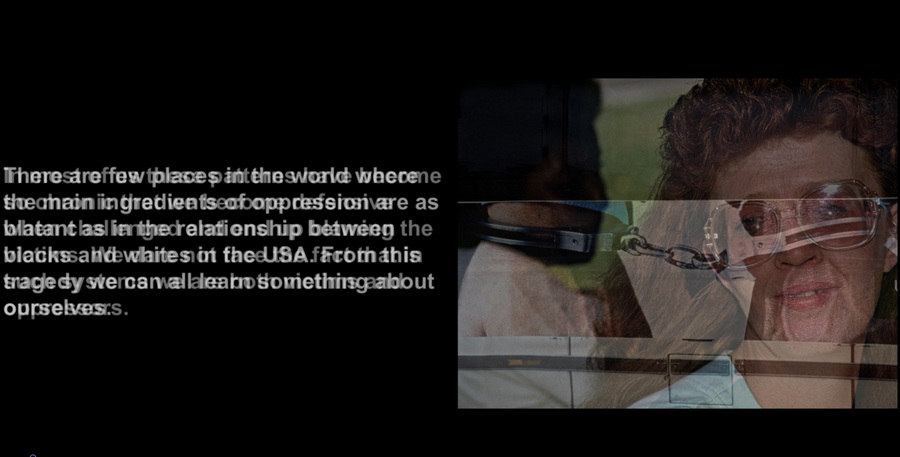
During the second or so of the dissolve, the two women are chained together,
like Tony Curtis and Sidney Poitier in The
Defiant Ones (1958).
While Holdt’s intertitles are stating that the patterns of racial distrust are
chronic, and that “we dare not face the fact that in such systems we are both
victims and oppressors,” we see, in the brief image of the dissolve, the chains
of that condition, we see a kind of collar around the black woman’s neck formed
by one of the handcuffs, we see the white woman’s head in some kind of clamp,
and we see that the white woman facing us “dare[s] not face the fact” that she
is both a victim and an oppressor, as the intertitle states. The dissolve
produces an unusually rich metonymic-metaphoric nexus, a nexus that is carried
forward to the next edit, which is another dissolve that uses the handcuffs to
link together black and white.
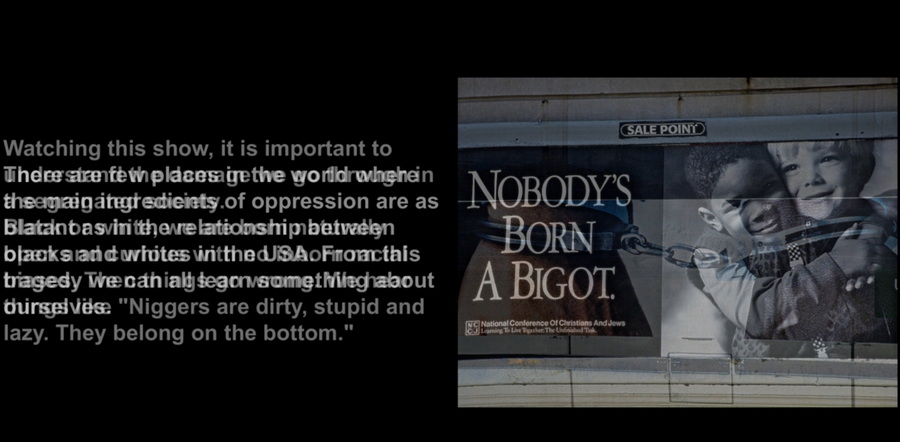
We can see in
the dissolving image that one of the handcuffs is now perfectly aligned with the
necks of two children, collaring them and clamping them together. When the
dissolve is complete, the image changes register again from compulsion and
discipline to affection and magnetism; instead of a steel clamp, a black child’s
arms are hugging a white child’s smiling face to his own, and the
collar/handcuff has dissolved.
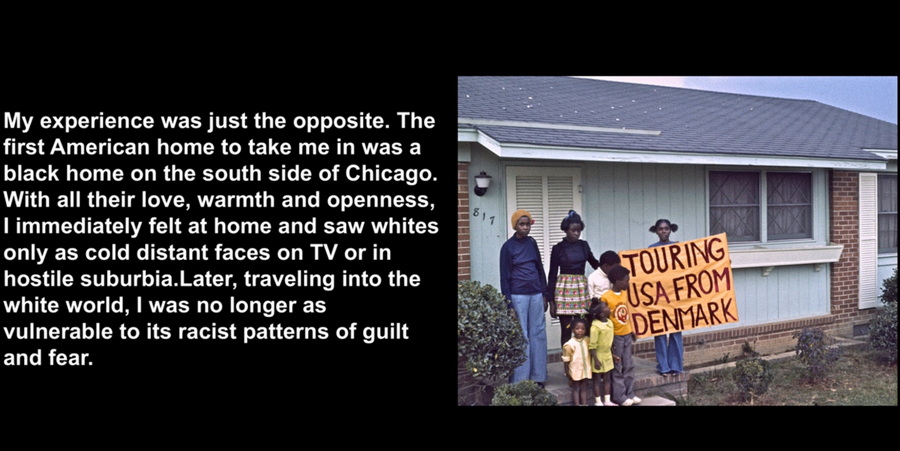
Holdt counts
himself lucky to have landed at this address first, since it
immediately preempted the racist assumptions prevalent in what he
calls the “distant faces on TV or in hostile suburbia.” The
denotative meaning of these visual and verbal juxtapositions is
clear, but the visual snapshot of the black home adds a possible
nuance. If one juxtaposes, in particular, the mainstream white idea
of the location of this home, “the south side of Chicago”, with the
image of the home itself, there is, for many white viewers, a
mismatch. The location “South Side of Chicago” is often rendered in
capital letters, and often connotes “ghetto”. But Holdt’s image
shows, not ghetto poverty, but an average tract house with a porch
light and house numbers like any working-class house in any American
suburb or small town. It is very like the average, white,
middle-class houses I grew up in, and there is no reason why it
should not look like that, except for the part of the mainstream
American mind that may have had difficulty reconciling that image
with a received idea of Chicago’s South Side.
The image of
this family home sets up another edit that, though not necessarily
as brilliant as the handcuffs-and-chains edits discussed previously,
is nonetheless careful and nuanced. In the image above, we notice
the girl holding Holdt’s hitch-hiking sign, “Touring USA from
Denmark”. We have consciously to assimilate that sign because it is
an aberration, since the phrase obviously does not refer to the
person holding the sign. It is the filmmaker’s sign that the girl is
holding. In the intertitles, the filmmaker is also narrating
something directly related to that sign: “Later, traveling into the
white world, I was [because of my initial stay with this black
family] no longer as vulnerable to [the white world’s] racist
patterns of guilt and fear.” That sentence refers directly to the
feel of this picture of an African-American home that is welcoming
to Danish strangers, but it also refers forward to the next picture,
the context of which is white.
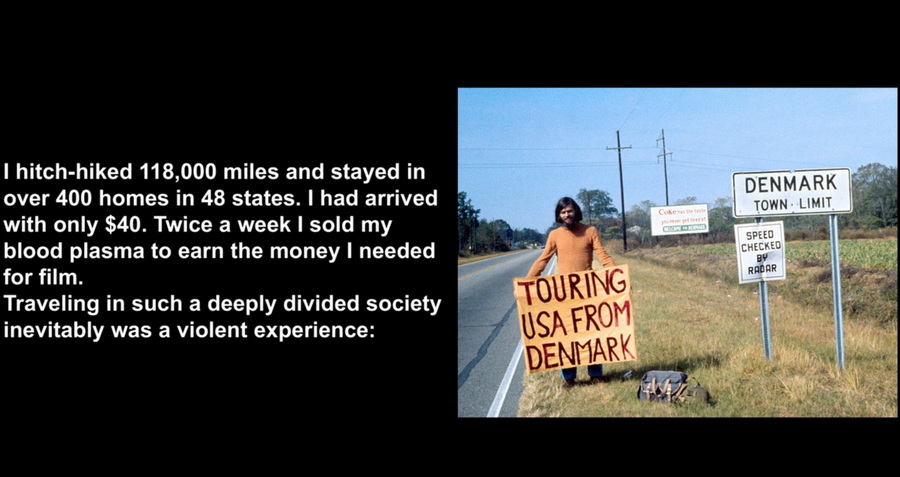
The edit
uses the punctum of the “touring” sign, which rivets the edit by its
placement almost in the same place in the frame as in the preceding
shot, overlapping with itself in the course of the dissolve from the
preceding shot to establish a graphic match between the two shots
across the edit. The “Touring” sign also becomes, within this new
shot, one term of a double punctum, the other term of which is the
“DENMARK TOWN LIMIT” sign. The intertitles accompanying the second
shot continue the reference to Holdt’s move away from the black home
in Chicago and into a racially divided America, referring directly
to the resultant violence. The picture does not yet show that
violence, but Holdt soon takes the viewer through his hair-raising
snapshots that will end this chapter of the film. The proximity of
this image with the violence that follows, and the binding of the
shot with the previous shot of the non-violent, welcoming,
African-American home, lends a nuance of anxiety to the peaceful,
rural, small-town American landscape around Denmark, USA. In fact,
the same “Touring USA” punctum will in a later double-punctum image
show a Ku Klux Klan billboard in the background of small-town
America. The anxiety Holdt associates with small-town America is
exactly complementary to the connotation of security in the South
Side Chicago family’s home, and a reversal of the American
mainstream norm of venerable small-town values.
Anxiety,
violence, and insecurity are the dominant issues of the rest of this
chapter of the film. Once Holdt introduces the issue of violence
with the “Touring USA from Denmark” sequence, he accompanies those
ideas with images of places in small-town and urban America that
most Americans would never go.
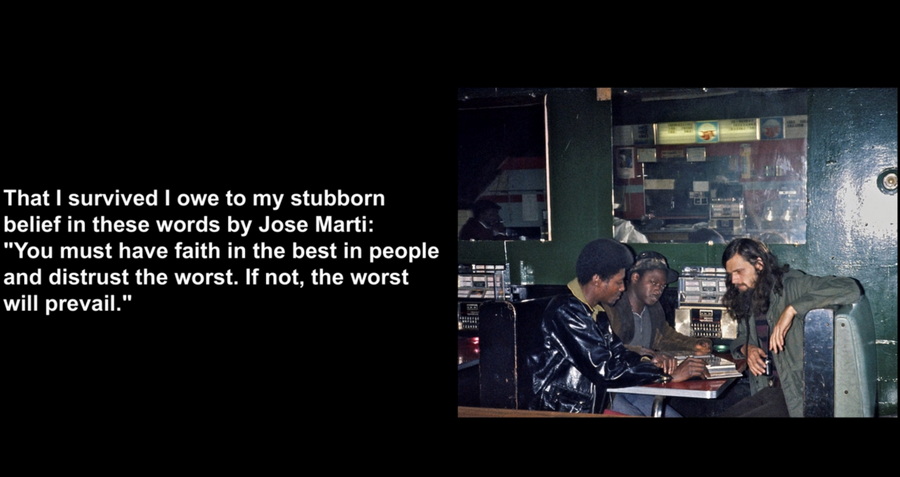
Reasons why
one would want to avoid such places are recognised by Holdt, and
direct evidence of the danger is shown in Holdt’s documention of
physical violence, including possibly murder, later in this chapter.
But, as the intertitle of the above shot implies, Holdt is committed
to the basic goodness of the people in these places, and his project
is to bring the viewer along.
He starts that journey by reviewing the history
of slavery. He constructs the journey as an attraction for the
audience. It is important to mention here that his use of sound, an
important element of film style, is a significant part of the
editing here and a major element of the film journey’s attraction in
general. The film’s first chapter thus far has been accompanied by
sounds representing the creaking hull of a heavy wooden slave ship
rolling on the high seas. When Holdt’s mention of violence occurs
for the first time, an appealing but hauntingly minor-keyed music
begins. When the theme of black anger and violence becomes the main
focus of Holdt’s intertitles, popular black protest music from the
1970s or ‘80s is foregrounded on the soundtrack and its lyrics
become the film’s narration. These editing decisions create a strong
flow that sweeps the audience into territory it might otherwise want
to avoid. This is all occurring during sections of the film where
Holdt is giving the history lesson of slavery and introducing to us
the people who are dangerous, but who are also worthy of basic
trust, as Holdt’s own decades-long journey into their world is meant
to prove. Holdt’s editing, then, does not depend only on the
attractions of “epistephilia” that Bill Nichols has described, but
also on attractions such as sensational visual testimonials and
popular music such as Gil Scott-Heron’s “Whitey on the Moon.”
The editing
in the history-of-slavery lesson is extraordinary, as it would need
to be to hold the attention of average viewers, who are not famous
for their interest in history lectures. A good example of the
quality of the editing is the way Holdt ends that lesson. At this
point, he is letting recent Black American pop music about slavery
narrate the lesson, and as the song comes to an end,
eighteenth-century engravings are used to portray the flogging and
branding of slaves, with the lyrics of the pop song reproduced as
titles.
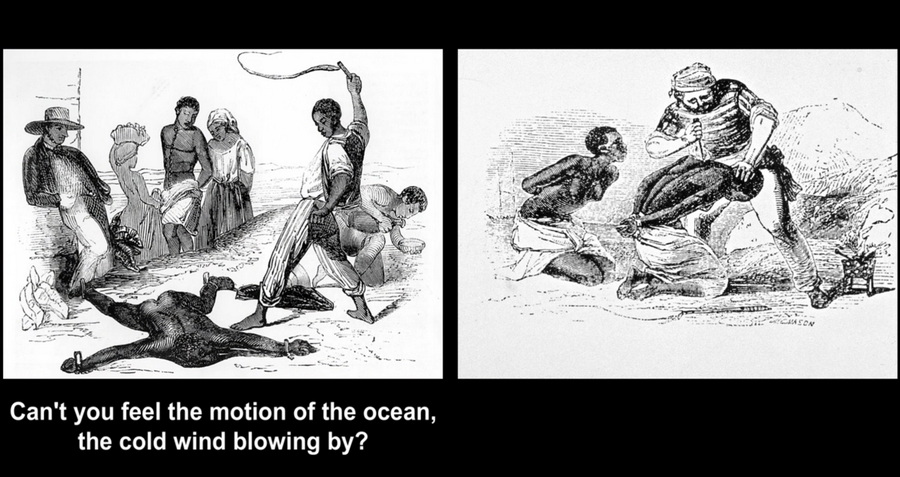
These prints
are followed by nineteenth-century photographic evidence of such flogging and
branding.
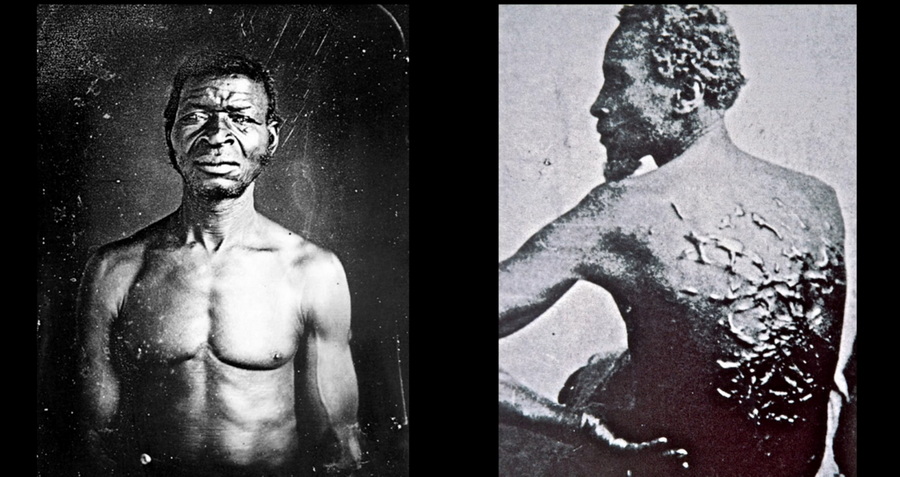
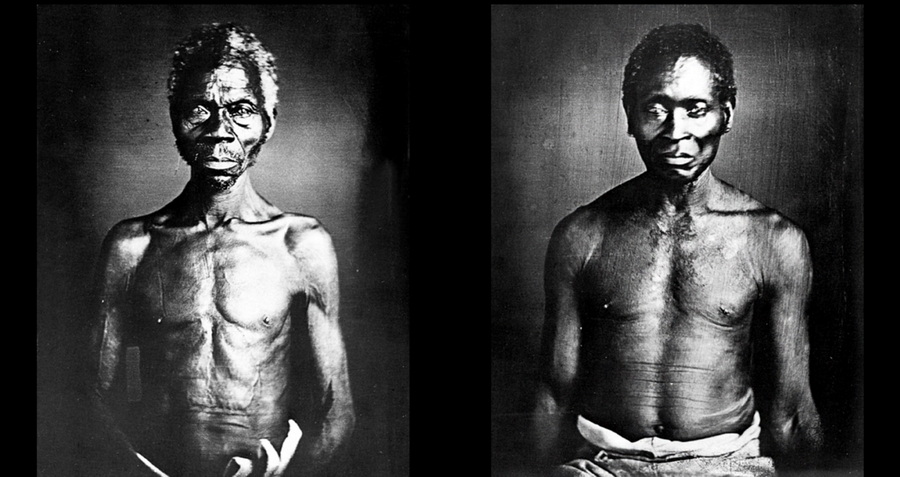
Then occurs
one of the most startling edits in the film, as these eighteenth- and
nineteenth-century documents – seemingly ancient history – are, without missing
a beat, replaced by Jacob Holdt’s own photographs of a “134-year-old former
slave.”
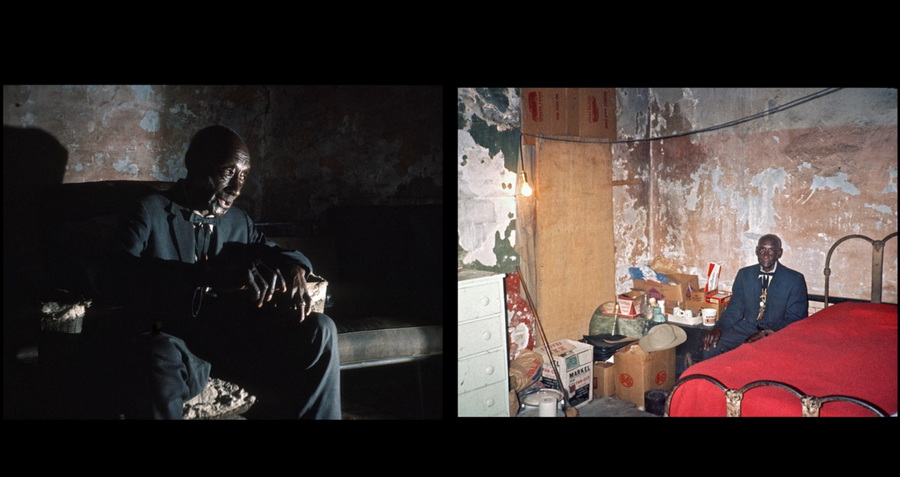
The power of
this move “out of history” and into the present is supported by a
similar edit on the soundtrack, where we hear Holdt’s voice for the
first time in the film, the voice of the person who will be
testifying to the truth of these conditions and of this sort of
audio-visual evidence, the voice of the Virgil who will guide the
audience for the next three or four hours. Holdt then one-ups this
strong sound edit by presenting the voice of the former slave
speaking for himself, which Holdt had recorded at the same time he
took the above images. This living example of America’s past is an
epiphany, the effect of which is magnified by the editing. Those
nineteenth-century, ancient-history images of physically mutilated
slaves come to life, morphing into colour, their tape-recorded
voices telling us their stories “directly”.
Holdt continues the history lesson, returning
to historical images, though now illustrating the testimony of an
“honest-to-goodness” former slave who was “really there” when those
old engravings, prints, and photographs were made.
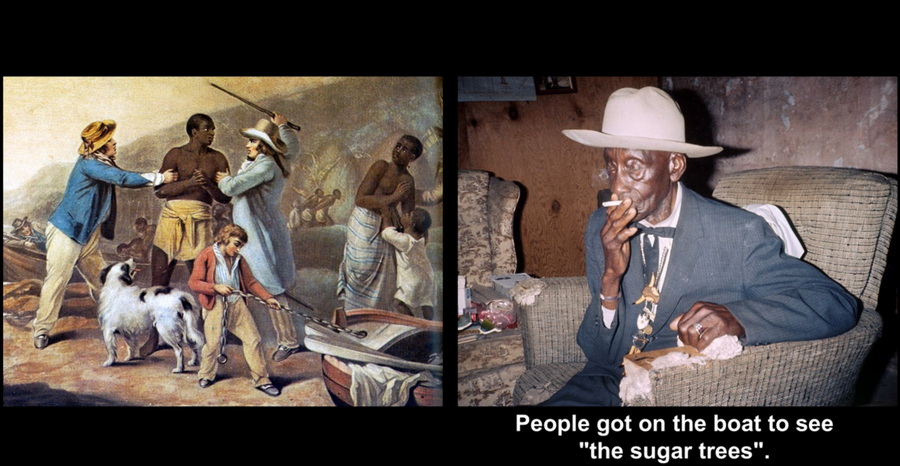
The most
uncannily lifelike of those accompanying images is from a diorama, probably
found by Holdt at a civil rights or history museum somewhere.
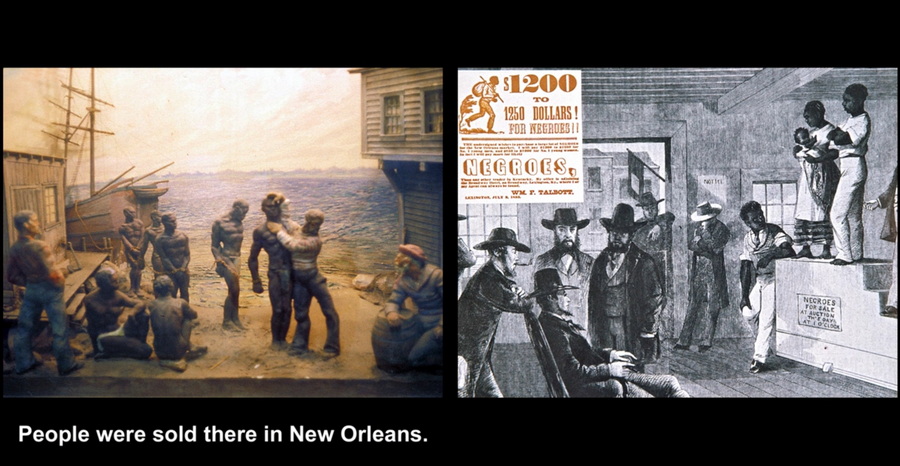
In the next
edit, the sculptural forms of the diorama on the left above, and the pedestal on
the right-hand image, are made to rhyme unnervingly with familiar post-slavery
monuments.
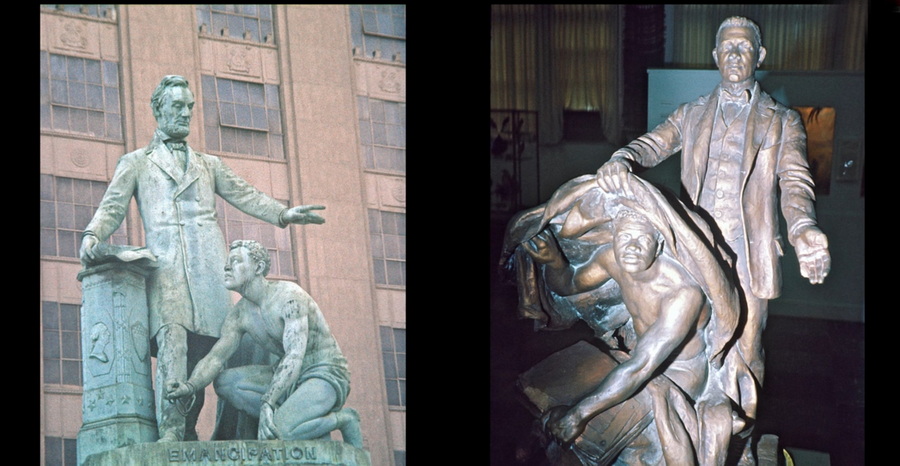
Holdt’s edit between these two diptychs of
frightening-vs.-comforting, three-dimensional figures implies that
the aspects of the history of slavery that we keep prominently in
public view are those that some of us – the white monument-funders –
prefer to remember. Holdt’s career-long project has been the
continual creation of a record that remembers differently, and
aspects of Holdt’s style, such as the edit above, contribute to that
differentiation of remembering.
Soon after
this sequence, Holdt continues the images of emancipation with
Martin Luther King, Jr.’s “I Have a Dream” speech on the soundtrack,
illustrated by both heroic portraiture and vernacular Holdt
snapshots.
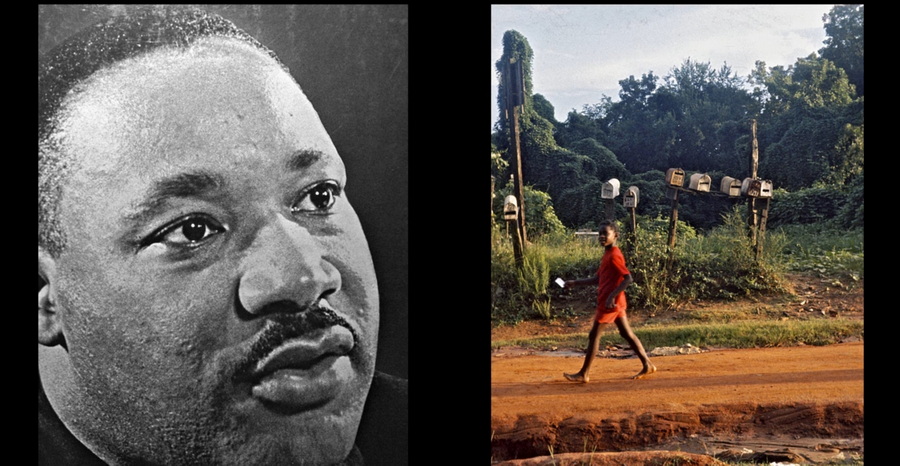
But
then, to conclude this opening chapter of his film, Holdt returns to the world
of today, decades after King’s speech, where African-Americans are still steeped
in poverty and murderous violence.
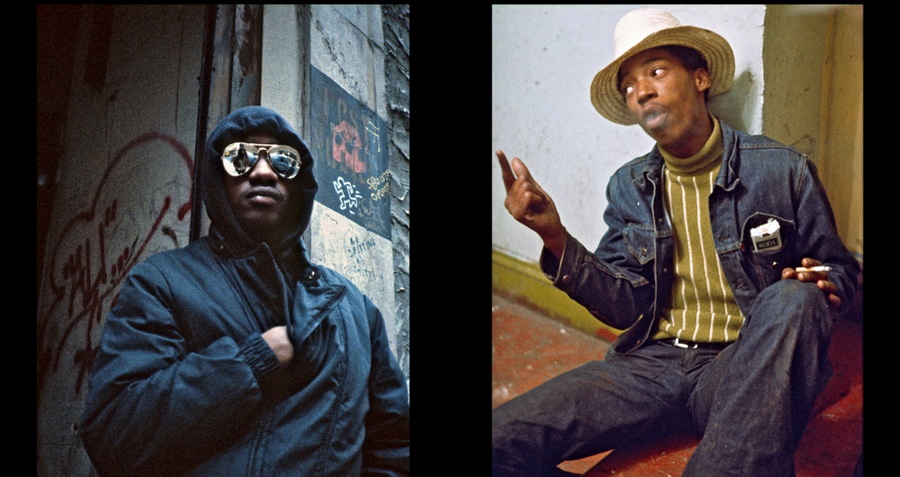
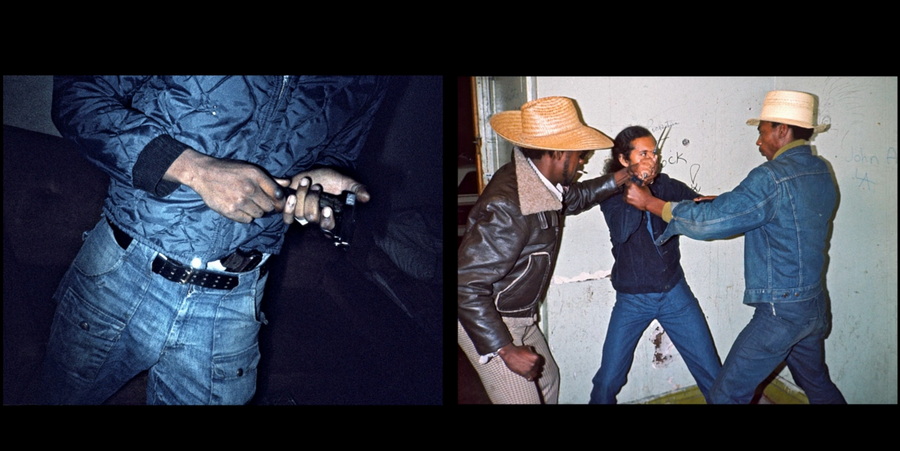
It is into
this world, primarily, that he invites the audience to follow him
for the remainder of the film.
Mise en scène
Mise en
scène is
the selection and arrangement of everything in front of the camera,
all the stylistic decisions that do not involve the handling of
camera and film. It includes, in fiction films, choices such as
actors, acting style, blocking, sets, locations, costumes, makeup,
art direction, and lighting. In documentary filmmaking, mise
en scène potentially
includes all of the above, but most generally it includes decisions
about what people and places to film, as well as how to alter and
arrange those people and places before or during the shooting.
Holdt’s mise
en scène can
be characterised is minimally arranged. He typically films people
and places as he finds them. He probably does not ask them to act or
re-enact; he does not use sets nor often alter the locations where
subjects and objects find themselves; his only lighting effects are
primitive flash when available light is inadequate to securing a
basic photographic record. He does not professionalise the interview
situation by constructing a dramatically lighted, talking-head, and
re-enactment aesthetics such as can be found in countless
documentaries like Errol Morris’s The
Thin Blue Line (1988)
or Fog
of War (2003)
or Alex Gibney’s Taxi
to the Dark Side (2007).
Nor does he schedule his filming of landscapes and locations to
utilise the sublime early-morning and late-afternoon light to add
aesthetic appeal or gratuitous sublimity, as so many documentaries
do.
He does,
however, intervene in some important ways in the situations that he
documents. He directs people to stand or sit for a picture, like the
family in front of their South Side Chicago home; he asks people to
take pictures of him in certain positions, such as standing beside
the “DENMARK TOWN LIMIT” sign. There are other such interventions,
but they are both transparent and minimal. Holdt’s people and places
are as ordinary as those in much of the mise
en scène on
YouTube. Also, the inclusion of these interventions is intrinsic to
the first-person nature of the project; Holdt, as filmmaker,
narrator, and storyteller, is always meant to be part of – and
active agent within – the story told. It would be more manipulative,
intrusive, and directorial of him to excise himself from the mise
en scène,
as is standard procedure in most documentaries.
Holdt’s
minimal treatment of the reality in front of his camera and tape
recorder, combined with the unprecedented range of his choices of
what sorts of people and places to film, is probably the most
rhetorically and aesthetically powerful aspect of his project. It is
the aspect of Holdt’s style that produces the effect of intimacy
that Jafa finds unique in Holdt’s work. One might be tempted to
think that Holdt’s minimalist realism, a kind of cinéma
vérité,
is the easiest of the stylistic elements available to him, since it
takes professional training, visual literacy, and skills to handle mise
en scène the
polished way that Alex Gibney and Errol Morris handle it. But in
fact Holdt’s way is not easy and its value is proportional to its
difficulty. The level of difficulty can be assessed in terms of
time, suffering, and risk. The material that Holdt presents is
almost-literally unbelievable – after all, he started the project
when his family and friends in Denmark refused to believe what he
was writing home about, and they sent him a cheap camera to prove
his claims. His incredible images and events, including the
occasional show stoppers that all documentarians hope for –
including his close encounters with inaccessible figures such as
1970s slaves in America’s sugar plantations; pre-Civil War former
slaves, all of whom one had assumed to be long dead; presidents’
daughters such as Julie Nixon; FBI directors such as Clarence Kelly;
famous Rockefellers and Kennedys; FBI informants and presidential
attempted-assassins such as Sara Jane Moore (who is still in prison
today); black-power martyrs such as Popeye Jackson – are available
to Holdt’s film because of the time and risk invested in the
project, and, in fact, as Holdt tells Jafa, because of his own
poverty as a filmmaker.
Human Scale Aesthetics
The levels
of time and risk invested by Holdt are simply too high for most
filmmakers to consider, and it is partly the viewer’s recognition of
the time and risk taken to deliver this material that makes the
experience of the film so affecting. But there is an additional mise
en scène effect
that adds value beyond the viewer’s recognition of the time and
risk. The unbelievable material – such as the plantation-like,
contemporary slave camps and the people who still eat dirt, and the
epiphanic close encounters with power, celebrity, and danger – are
human-scale. They emerge out of the life experience of a person much
like the average viewer, a person who has little wealth, no
professional film skills, no special access to power and celebrity,
and whose prior experience of the dangerous realities inherent in
the realms of racism, poverty, and crime is limited to fiction and
more-or-less distanced, objective documentary. The average viewer’s
documentary knowledge is derived from the institutions of
documentary – the evening news, National Geographic, the History
Channel, Frontline, the classical film-studies canon, and the like.
These days,
an increasing amount of the average viewer’s documentary experience
comes from new institutions like YouTube and similar platforms, but
that is my point. Holdt’s project foreshadows that YouTube world of
publicly accessible films by ordinary people. YouTube is the world
from which the somewhat younger Jafa draws for his own powerful
work. Holdt’s earlier œuvre has the authority of those works in that
it is embedded in ordinary lives, including Holdt’s own drop-out
vagabonding. While it falls short of perfect authorial authenticity
by not being
a documentary by the
people it portrays in that vagabonding, it rises well above the
average YouTube work by its unprecedented investment of time
(virtually an entire life), of suffering (Holdt was often
miserable), and literally the risk of life and limb.
This
investment of human-scale labour and bodily and psychic risk-taking
is what makes Holdt’s mise
en scène,
and his entire resulting aesthetic, significant. The effect of a
professional, capitalised-scale documentary film that attempted to
do what Holdt has done would be different; the more capital value –
such as camera quality, production and post-production skills – that
one might add to the project would proportionally alienate the mise
en scène from
the people, places, and situations portrayed, and that alienation
would be visible and audible to the viewer.
Holdt’s film
has the feel of an unusually careful and thoughtful home movie. And
since almost anyone can make a home movie today, Holdt’s mise
en scène contributes
to a democratic aesthetic. Michael Moore’s, Errol Morris’s, and Alex
Gibney’s movies do not look homemade; few viewers feel when watching
such films that they look like home movies that they could have made
themselves. Thus, Moore’s, Morris’s, and Gibney’s films, important
as they are to the democratic process, are less democratically
produced, and thus less fundamentally democratic, than Holdt’s. This
suggests the question as to which aesthetic is more effective,
Holdt’s or Gibney’s, which is a good question but that is not the
issue here. My point is that if one is looking for aesthetics that
can produce films as powerful and affecting as any in film history,
and that at the same time are truly democratic, Holdt’s project is
an instructive model, one that cannot be matched by better financed,
more-widely distributed films. There is apparently an art of cinema,
which I am calling Poor Cinema, that is not only beyond the reach of
money, but is averse to money, and it can be more sophisticated in
its making, and more affecting in its beholding, than most
filmmakers and audiences are yet aware of.
The Poor-Cinema Project
To begin
this essay, I mentioned that Arthur Jafa had praised the uniqueness
of the content and style of Holdt’s images, and had admired the
authenticity, effectiveness, and integrity of those pictures. Jafa
compared Holdt’s images favorably to similar images by artists
firmly in the canon, such as William Eggleston, and I have compared
Holdt’s filmmaking to canonical filmmakers such as Michael Moore. In
search of general principles to explain the relative value of
Holdt’s work, this essay has explored one aspect of the images and
filmmaking that Jafa and I have admired – their style. It appears
significant that Holdt’s style grew directly from his working
conditions.
In the
larger-scale book project on poor cinema, the unpublished chapters
that follow this essay dig more deeply into the specific filmic
content that Holdt’s methods produced, including specific critical
targets, and issues of critical integrity – specifically in relation
to money. The larger poor-cinema project includes my two books on
Oscar Micheaux, plus a manuscript on Terminator
3; Rise of the Machines (Jonathan
Mostow, 2003) as an example of a critically ambitious rich cinema.
The larger hope for these essays is to encourage more attention to
under-the-radar modes of relatively inexpensive filmmaking, wherever
worthy examples are found. Poor cinema is an acquired taste, but a
taste worth acquiring.
Endnotes
Copyright © 2010
AMERICAN PICTURES |
|





















